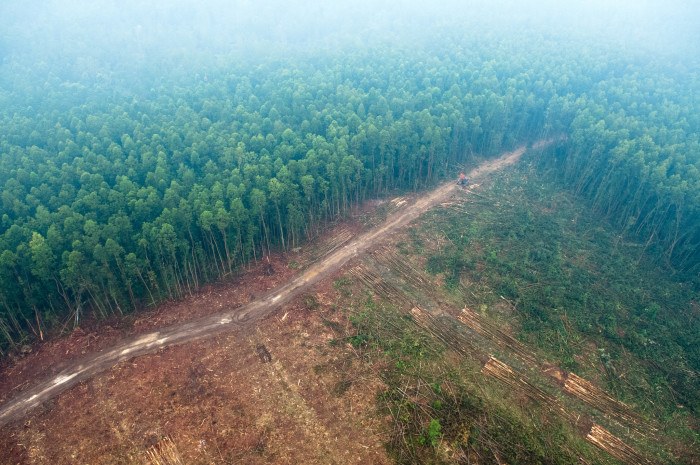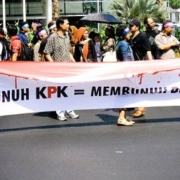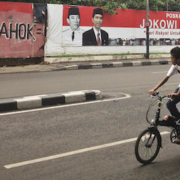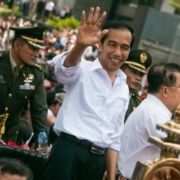
The haze blanketing much of Kalimantan and Sumatra has come to define Jokowi’s environmental record in his first year. Photo by Aulia Erlangga for the Center for International Forestry Research.
President Joko “Jokowi” Widodo and Vice President Jusuf Kalla recently marked one year in the job, in a month that has provided two stark reminders of the administration’s disappointing record in the environmental sector.
The first is, of course, the haze blanketing much of Kalimantan and Sumatra, which experts are now suggesting could last until 2016. The second is the brutal death of Salim Kancil, an environmental activist who was allegedly tortured and killed over his opposition to a sand mine in Lumajang, East Java.
These cases have come to define Jokowi’s environmental record in his first year. They have overshadowed positives, such as the president’s decision to grant clemency to environmental activist Eva Susanti Bande, the extension of the forest-clearing moratorium, and systematic improvements in the fisheries sector, led by Minister Susi Pudjiastuti.
These two problematic cases illustrate the wider challenges the government faces in the environmental sector. They are a useful starting point for analysis of Jokowi’s progress in his first year in power. Both have their roots in poor environmental governance and the longstanding nexus of politics and business in the management of natural resources.
Planning
Two governance issues stand out from the long list of environmental and natural resource planning issues that the government must address: spatial planning and the “one map” policy.
Jokowi’s early move to establish a new Ministry for Agrarian and Spatial Planning was a sign that the government recognised the importance of getting spatial planning right. Unfortunately, the fact that the old National Land Agency (BPN) now forms the backbone of this new ministry limits the benefits of the change. The BPN was responsible for the administration of non-forested land, and this will continue under the new ministry. Forested land, meanwhile, will continue to be the domain of the Environment and Forestry Ministry, which means the poor ministerial coordination that has dogged the sector in the past will continue.
A further concern is that the Jokowi government has appeared to show only limited interest in advancing the “one map” policy initiated by the previous administration. Under President Susilo Bambang Yudhoyono, the Geospatial Information Agency (BIG) was tasked with developing a basic map for use by all ministries to overcome the problem of conflicting sectoral maps with different data and mapping standards. But after its launch in December 2014, progress seems to have stalled. Failure to prioritise the one map policy will only impede future efforts to resolve land tenure conflict and improve law enforcement.
Both of these initiatives are instrumental for improving zoning, for example to protect deep peat and prevent it being dried out for plantations – a contributing factor to the haze. The lack of a single consistent map also makes law enforcement much harder when agricultural fires occur.
Land licensing
A perennial problem for governments in Indonesia is land tenure conflict, which may also contribute to forest fires. Conflict has its genesis in complex and non-transparent licensing processes, with weak connections between different levels of government, which provides room for the illegal granting of land-use licences. The Yudhoyono administration developed a three-pronged approach to the problem. This involved (1) a review of all existing licences, with the potential for cancellation of improperly issued licences; (2) a program to map and register local and indigenous claims to land, designed to address the discrepancy between small holders and big business that contributed to many conflicts; and (3) development of an integrated online licensing mechanism and national database of licences related to use of natural resources.
The Jokowi administration has so far only acted on one of these issues, by streamlining the licencing process. As part of the second economic stimulus package announced last month, the government said it would slash the processing time to obtain ‘borrow to use’ forest area permits (izin pinjam pakai kawasan hutan) to 3-12 days. These permits (which can be used for mining activities inside forested areas) used to take up to four years to process.
Even if the process is sped up, however, it will still be problematic. The absence of efforts to map local and indigenous claims to land means there is a risk that permits that seem fine on paper when issued will still be subject to conflicts when implemented. This is not to suggest the government is ignoring community claims to land completely. The Ministry of Environment and Forestry has established two ad-hoc teams for conflict resolution and licence review. Unfortunately, records of their progress are not publicly available.
Law enforcement
The Jokowi administration’s record is mixed on law enforcement. Given the cross-sectoral nature of environmental and natural resources management, law enforcement efforts must prioritise coordination. This was recognised by Jokowi and Kalla in their list of priority programs, the Nawa Cita, which included plans to develop special taskforces to combat illegal mining, fishing and logging. These taskforces were to be staffed with officials with demonstrated experience and capacity to manage such complex cases.
One year on, however, only the special taskforce on illegal fishing has been established. The absence of systematic efforts to strengthen law enforcement in the environmental and natural resources sector contributed to the murder of Salim Kancil, in part at least. There are suggestions that police failed to act on reports of environmental destruction and threats to local community members.
One promising sign has been the efforts of law enforcement officials to investigate hundreds of companies for their connection to agricultural fires causing the haze that is enveloping large swathes of western Indonesia and nearby countries. This does not, however, guarantee these companies will be sanctioned. Experience shows that as soon as the public stops paying attention, police investigations – particularly those involving big businesses – are prone to vanishing without clear explanation.
Strengthening environmental and natural resource governance requires legal and policy reform and strong coordination among ministries and institutions. Success or failure cannot be pinned on one institution but is heavily dependent on effective political leadership from the president and his deputy. Unfortunately, the critical issues outlined above are nowhere to be found in the list of 100 priority programs of the new administration. The only forestry issues mentioned are rehabilitation and protection of wildlife. These are important, no doubt, but they fail to touch on the complex governance issues that have prevented progress in the past.
The absence of strategic direction from the president’s office has left each minister to develop their priority programs independently, leading to the Ministry of Environment and Forestry, the Ministry of Agrarian Affairs and Spatial Planning and the Ministry of Maritime Affairs and Fisheries all developing quite different approaches.
It is not fair to put all the blame for all these deep-rooted environmental and natural resource problems on the shoulders of Jokowi and Kalla. But one year is enough time to learn. The haze and the murder of Salim Kancil should be loud warnings to the administration of the pressing need to re-evaluate its policies and strengthen coordination among members of the cabinet on environmental issues.








